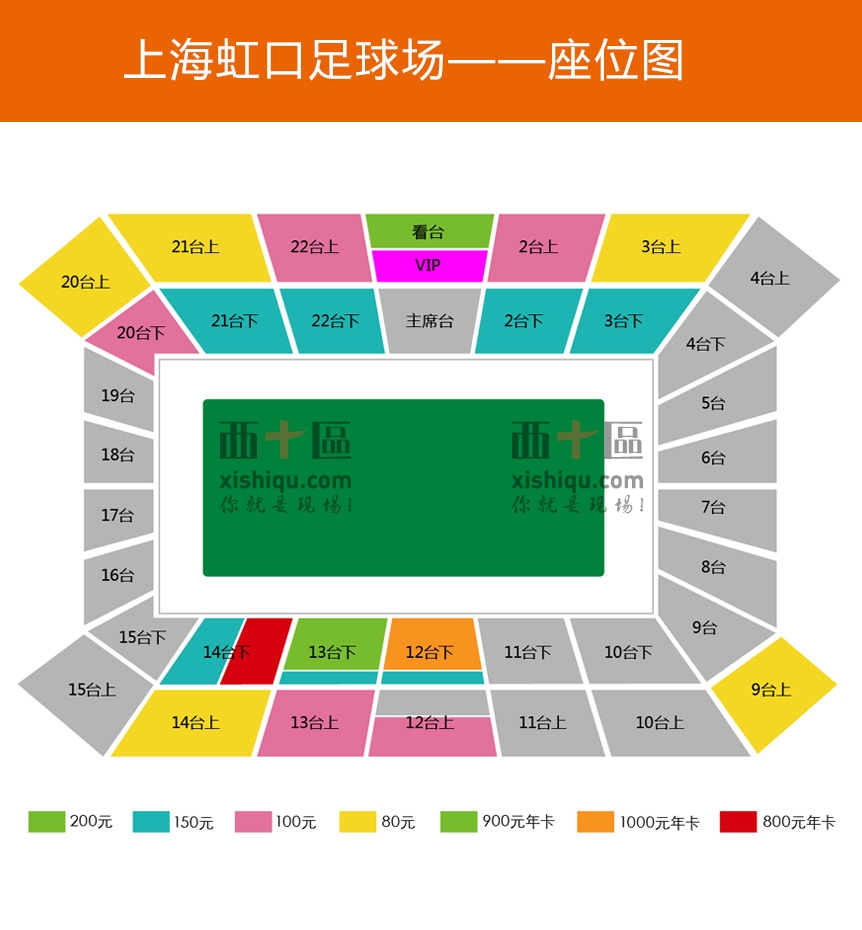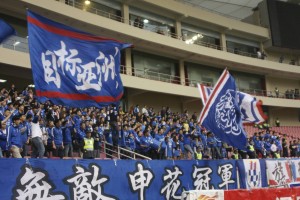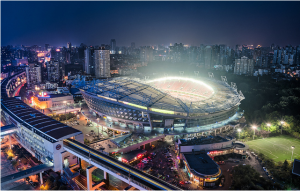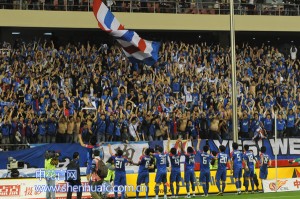You’re aboard elevated metro line 3. The train climbs away from ground level at Shanghai Railway station and snakes through the northern districts of the city proper, affording a impressive view of the supertall skyscrapers accross the Huangpu river in Lujiazui. Minutes later, the line ascends even higher and Hongkou Football Stadium sweeps majestically into view. Congratulations – you just arrived at the hands-down best football ground in China.
The Shanghai football scene may be crowded these days with the rise of Shanghai SIPG (formerly East Asia) and the nomadic and mostly irrelevant Shanghai Shenxin, but Shenhua is the club in the city with the most fans, longest history, most impressive ground, best atmosphere and therefore a solid choice for those interested in an authentic Chinese football experience.
Club news and fixtures
First of all, you’ll need to gather some info and background of your own. For all the latest developments on Shenhua, look no futher than ‘s very own Steve Crooks and his North Terrace News column. There is also your very own correspondent’s Twitter feed which has a steady stream of observations about Shenhua, plus a fairly active unofficial Shenhua facebook page. Wikipedia’s page on the club is reasonably accurate and is a good guide to the squad.
To find out when games are, check the fixture list on the club’s English website. Be warned though, it is not unknown for Chinese Super League games to be rescheduled at late notice. Furthermore, Shenhua’s English language website leaves something to be desired; your correspondent strongly recommends checking the Chinese version of the fixture list to be certain of when matches take place. Most of the time you’re probably fine using the English list. But certain seasoned Shenhua followers have on at least one occasion turned up at Hongkou to find the stadium deserted. Ahem.
Which fixtures are best? There are two standout games – the visit of traditional rivals Beijing Guoan, and the Shanghai Derby, which is back with avengence. Other matches worth choosing over others include champions Guangzhou Evergrande, and Yangtze delta derby rivals Jiangsu Sainty from Nanjing who always bring a huge support. The game against Shandong Luneng has lost its shine in recent seasons as the fortunes of both sides have waned somewhat. However it’s still one of the better games. The visit of Hangzhou Greentown, the other Yangtze Delta Derby is also reasonably juicy. However, don’t be fooled by Shanghai Shenxin. They have few fans and games between Shenhua and Shenxin aren’t really fit to be described as derbies.
Getting there
Hongkou has its own metro station of the same name and is served by lines 3 and 8. Amusingly, local English media sometimes refer to the ground as “Hongkou Soccer Stadium” despite there being a huge sign marked “Hongkou Football Stadium Station” right next to the ground. Nevertheless, the stadium is very well connected – for out of town visitors, line 3 links directly with Shanghai main railway station and Shanghai south railway station. Those unfamiliar with Shanghai’s metro system note well – be sure to board line 3 (yellow) and not line 4 (purple). These two lines share a large section of track and the same platform at 10 stations . A frustrating u-turn awaits the unwary match-goer who takes a line 4 train by accident, as these two lines go their separate ways before line 3 reaches Hongkou Football Stadium Station. You may also arrive at this station on line 8, if so take exit 1, you’ll emerge on the south side of the stadium and not need to cross any roads.
Bus options are even more plentiful, the following routes stop close by the stadium: 13,19,24,36,54,63,68,76,105,106,112,113,138,206,223,506,516 550,563,738,768,830,866,922. Also bus line 4 from Pudong Airport goes via Hongkou Stadium.
If you are taking a cab simply say “hongkou zuqiu chang” – every taxi driver in Shanghai knows where it is.
Getting tickets
There is a ticket office in the building nearest metro exit 1 of the nearby station, next to the KFC. Prices vary – take the seating map below as a very rough guide.
 Sections 4, 5, 6 and 7 compromise the infamous “North Terrace” – it’s home to the Blue Devils (Lanmo), one of China’s most long-standing and respected fan groups. Modelled on the Ultras style of southern Europe, this is the most atmospheric part of the ground. Sections 8 and 9 have been kept empty for security reasons in recent seasons – away fans fill section 9 in the upper tier. Section 10 is sometimes also used games with very large travelling supports such as local rivals Shanghai SIPG and Jiangsu Sainty.
Sections 4, 5, 6 and 7 compromise the infamous “North Terrace” – it’s home to the Blue Devils (Lanmo), one of China’s most long-standing and respected fan groups. Modelled on the Ultras style of southern Europe, this is the most atmospheric part of the ground. Sections 8 and 9 have been kept empty for security reasons in recent seasons – away fans fill section 9 in the upper tier. Section 10 is sometimes also used games with very large travelling supports such as local rivals Shanghai SIPG and Jiangsu Sainty.
At the opposite end of the ground, are the Blue Boys, another Ultras-style group in the same vein as the Lanmo. Generally this group is a bit younger and more extreme, but, both are welcoming of newcomers, especially if you have a foreign face.
How to get in there? That’s a part of the adventure you will have to work out for yourself. At any rate, it’s easy to get tickets for most parts of the ground, the games hardly ever sell-out. If you choose to buy from a street seller, this is usually fine, but don’t pay much more than 50rmb or so unless its a big game such as Guangzhou Evergrande, Beijing Guoan or the Shanghai Derby.
Pre-match
As Shenhua fans are so fond of saying “This is Hongkou” and on match day itself you can’t help but feel it. Because of the local geography, almost everyone enters the stadium from the west and south sides. This makes the area around the elevated metro and the front of the stadium a buzzing hive of pre-match activity. Hawkers sell club memorabilia and all manner of knick-knacks. Horns, whistles, hats, inflatables, sunglasses, giant foam hands and luminous devil horns can an all be gotten for a few RMB if one is prepared to bargain. For those worried about sightlines in the stadium, it’s even possible to buy a pair of binoculars on the street outside the ground.
All around you’ll find groups of fans hanging around soaking up the pre-match atmosphere, catching up with friends and indulging in pre-match rituals. In the south-west corner of the ground in the building with the Stadium ticket office, there are a couple of restaurants packed with Shenhua supporters.
In the past year however, pre-match favourite haunts have changed somewhat. The Qingdao Pub on the corner of Sichuan Lu and Dongjiangwan Lu is no more, leaving the whole area without a dedicated watering hole. The infamous Tan Hotpot restaurant above the KFC was the pre-match “pub” for many local fans, but it was closed for most of last season. It has since reopened under the same owners, but is less than half its original size, and has been rebranded to try to create a more upmarket hotpot experience, one that seems to be at odds somewhat with rowdy football supporters. It remains to be seen if it will once again become centre of pre-match activity this season.
However, eating alongside fans in a restaurant near the ground on match day is the quintessentially Chinese part of the local football experience, particularly for big games. Thousands gather in eateries in the neighbourhood of the stadium to eat, drink and sing before matches, often to the disdain of other diners.
Other eating and drinking options are the convenience store near the KFC which sells cans of beer, as does a small shack a hundred meters north up Dongjiangwan Lu.
Accross the road, the upper floors of the adjacent Cloud Nine Mall have higher end eats on offer, and on Sichuan Lu there’s cheaper local fare to be had, if you just want to fill your belly before the game.
Entering the stadium
Access to the stands at Hongkou is gained via a raised concourse which completely encircles the stadium. Ticket checks just to get on the concourse are standard, so have your tickets ready well before you reach your gate. This is also a major inconvenience for latecomers whose tickets may be in the hands of friends already in the stadium. Or more to the point, an inconvenience for those who must exit the stadium and walk quite some distance to the concourse gates to hand over said tickets.
For big games, there is a police barrier blocking the way between sections 7 and 8. So if you are in the general area of sections 4,5,6 or 7, make sure you walk clockwise around the concourse lest you find your way blocked and have to retrace your steps.
 Chinese football fans tend enter the stadium well ahead of kick-off, so if its a big match, best head in early if you want good seats. Besides, people tend to sit anywhere in their section and ignore the seat number on their tickets. Those who make it early enough will be treated to the team line up being announced, complete with with video footage on the stadium scoreboard of the players folding their arms and turning to face the camera wearing serious expressions.
Chinese football fans tend enter the stadium well ahead of kick-off, so if its a big match, best head in early if you want good seats. Besides, people tend to sit anywhere in their section and ignore the seat number on their tickets. Those who make it early enough will be treated to the team line up being announced, complete with with video footage on the stadium scoreboard of the players folding their arms and turning to face the camera wearing serious expressions.
Hongkou Football stadium is one of only two in the CSL (Tianjin Teda’s ground being the other) which are purpose-built for football – which basically means no running track.
This helps give the stadium more intimacy. Even although the 33,000 capacity stadium is only half full most of the time, it’s still one of the most atmospheric grounds in the country with excellent acoustics. If you’ve found a way into the north or south terraces, you might want to read our guide to Shenhua chants and join in. Otherwise, soak up the atmosphere, and the better views, from the side stands.
There will be a national anthem just before kick-off. For a game involving no national teams, this may seem a bit pointless to some, depending upon where you are from. Nevertheless, it warms up the crowd’s singing voices for the match ahead.
The Chinese football experience is as much about simply being there and taking in the ambience, and people-watching, as much as it is about focusing on the matches themselves, which although of a higher standard than given credit for, aren’t up to the standards of EPL or Bundesliga. If you’re looking for that kind of match, you’re missing the point.
Half-time
Half-time sees fans spill out onto the concourse to seek refreshment. Surprisingly for such a food-centred nation, options for eats during this period are limited. Some stalls sell pop-corn and soft drinks, which can be taken back inside the stadium as long as they are in paper cups. Conveniently so can beers. These used to be widely available at half-time from vendors, for 10rmb a can. However, last year, beer was suddenly no longer on sale. We can only speculate why – disorder of any kind is very rare at Hongkou, alcohol fuelled or not. Worry not though, if your half-time thirst is unquenchable by flat Coca-Cola, you can dash down to the Family Mart convenience store on the main street next to the stadium. Vendors may even give you a paper cup to pour your beer into so you can finish it off in the ground.
Depending on how the match is going, fans may not return to witness kick-off for the second half in a timely fashion. However, most are back by the 48th minute or so if they are not too engrossed in conversation on the concourse, or dismayed by Shenhua’s first-half performance.
Post-match
In Europe, the end of the game often signals a sudden departure by just about everyone except the ground staff once the final whistle goes. But in China, and particularly at Hongkou, often the fun has only just begun when 90 minutes are up. Normally, players will salute both ends of the stadium – all 11 will join hands and raise their arms up and down repeatedly whilst bowing infront of the terrance to thank the fans for their support, as the fans reciprocate en mass with a similar gesture. In China much importance is attached to this ritual, and it is considered a breach of Etiquette for players to not approach the terrace, even in the aftermath of a bad defeat. In the case of such a negative result, it’s still worth sticking around, either to vent your own frustrations, or to simply observe the intriguing scenes, as the players sheepishly make their way to the goaline to make half-hearted apologetic gestures to a chorous of boos – or worse.
Should the team win a big game, then the big stairwell between the stadium and the elevated metro line 3 station becomes a replica of the north terrace as celebrations get wild. Songs, dances, chants, burning of opposition jerseys and colours are commonplace, and on occassion fireworks and distress flares may be set off. Police usually put a quick end to pyrotechnics however, and such instances are less and less common.
At this time, it can be difficult to get away from the ground due to the crowds so you may find yourself witnessing, or even unwittingly taking part in these celebrations even if you are simply trying to make your way to the metro or other point of exit. The hardcore fans may wait even longer to mob the team bus when it finally emerges, but most people have left the scene by then to continue celebrations elsewhere – it is easy to be invited to such events.
If you simply wish to head home, metro is best option, trains are still running after night games. But be warned, line 8 exit 1 is always closed, as are the walkways to line 3, forcing thousands of fans to jaywalk accross a busy road to get to the station.



